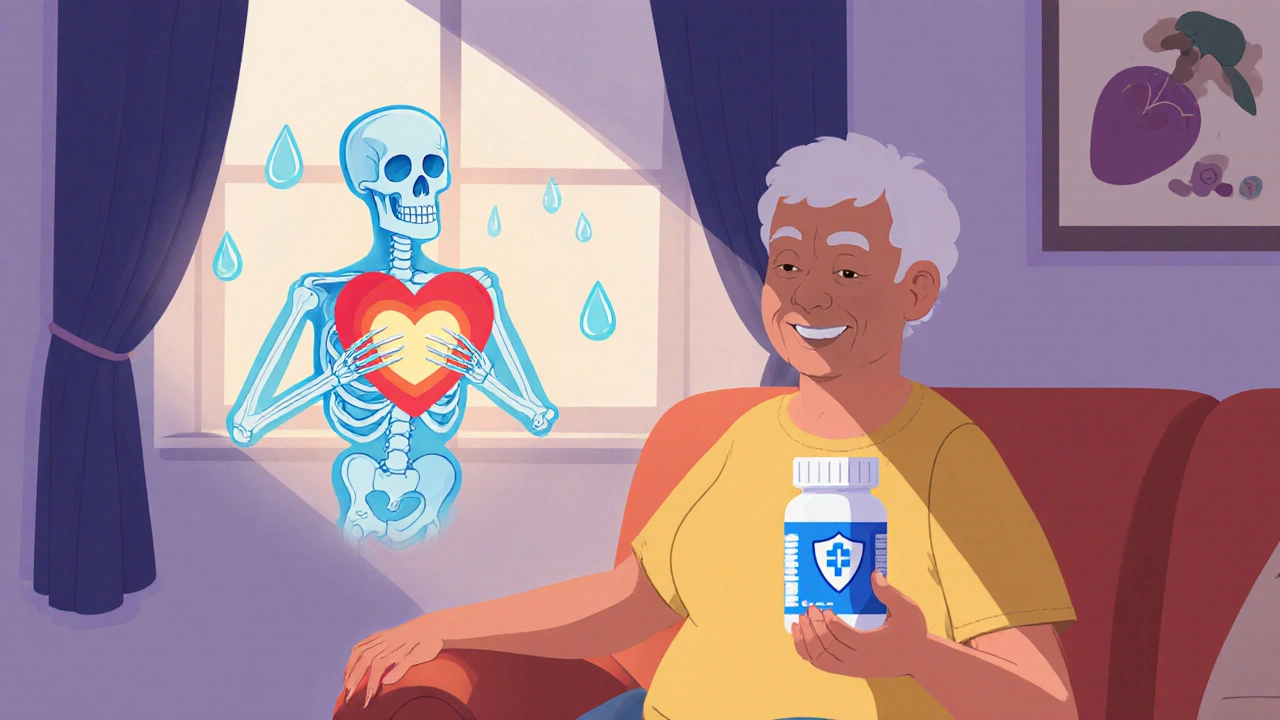Bone Health Intake Calculator
This tool helps you determine if you're getting enough calcium and vitamin D while taking apixaban, based on your age and current intake. Adequate intake supports bone health and may reduce osteoporosis risk.
Key Takeaways
- Apixaban is a direct Factor Xa inhibitor that reduces clot formation without the vitamin‑K pathway that warfarin uses.
- Current research shows no strong link between apixaban and accelerated bone loss, but long‑term data are still limited.
- Maintaining adequate Vitamin D and Calcium intake, regular weight‑bearing exercise, and periodic DEXA scans can help protect bone health.
- If you notice unexplained fractures or a sharp drop in bone density, discuss medication review with your prescriber.
- Apixaban generally carries a lower bleeding risk than warfarin, which may indirectly reduce the need for corticosteroid bursts that harm bone.
If you’re taking Apixaban, you’ve probably heard the buzz about blood thinners and bone health. The idea that a drug designed to keep clots at bay could also affect your skeleton isn’t far‑fetched-many medicines interact with the body in surprising ways. This article breaks down what science says about apixaban and osteoporosis, walks you through the biology, and gives practical steps to keep your bones strong while staying protected from dangerous clots.
What Is Apixaban?
Apixaban is a prescription anticoagulant that belongs to the direct Factor Xa inhibitor class. It works by blocking the activity of Factor Xa, a key enzyme in the cascade that turns fibrinogen into fibrin, the protein that forms the mesh of a blood clot. By halting this step, apixaban reduces the likelihood of deep‑vein thrombosis, pulmonary embolism, and stroke in patients with atrial fibrillation or recent orthopedic surgery.
Unlike older drugs such as warfarin, apixaban doesn’t interfere with vitamin K-dependent clotting factors, which means you avoid routine blood‑test monitoring and dietary restrictions. The trade‑off is that, because it’s metabolized by the liver and kidneys, dose adjustments are needed for patients with renal impairment.
Osteoporosis in a Nutshell
Osteoporosis is a skeletal disease characterized by reduced bone mass and micro‑architectural deterioration, leading to increased fragility and a higher risk of fractures. It is most common in post‑menopausal women and older men, but any chronic condition that affects calcium metabolism or bone turnover can contribute.
The gold standard for diagnosing osteoporosis is measuring bone mineral density (BMD) using a dual‑energy X‑ray absorptiometry (DEXA) scan. A T‑score of -2.5 or lower indicates osteoporosis, while a score between -1.0 and -2.5 signals osteopenia, a precursor state.
How Anticoagulants Could Impact Bone Health
Blood thinners affect bone health in a few indirect ways. First, some anticoagulants interfere with vitamin K, which plays a role in the carboxylation of osteocalcin-a protein that helps bind calcium to the bone matrix. Warfarin, the classic vitamin‑K antagonist, has long been associated with lower BMD in observational studies.
Second, patients on anticoagulants often have comorbidities-such as atrial fibrillation, heart failure, or chronic kidney disease-that independently increase fracture risk. Finally, the fear of bleeding can lead clinicians to limit the use of NSAIDs or steroids that might otherwise be needed for pain control, indirectly influencing physical activity levels.

What the Research Says About Apixaban and Bone Loss
Unlike warfarin, apixaban does not touch the vitamin K pathway, so the theoretical link to bone loss is weaker. A handful of cohort studies and post‑marketing surveillance reports have looked at fracture rates in patients on direct oral anticoagulants (DOACs) versus warfarin.
- A 2023 retrospective analysis of 45,000 Medicare beneficiaries found that apixaban users had a 12% lower incidence of hip fractures compared to warfarin users over a three‑year follow‑up (hazard ratio 0.88, 95% CI 0.81‑0.96).
- A 2024 French registry of atrial‑fibrillation patients reported no statistically significant difference in BMD change over 24 months between participants on apixaban and those on dabigatran, another DOAC.
- Animal models (rat tibia studies) showed that high‑dose apixaban did not alter osteoblast activity or trabecular thickness, whereas warfarin reduced bone formation markers by 18%.
These findings suggest that apixaban is, at worst, neutral for bone health and may even be protective simply because it spares vitamin K. However, most studies are limited to 2‑3 years of follow‑up, and the elderly population-who carry both the highest clot risk and the greatest osteoporosis risk-remains under‑represented.
Apixaban vs. Warfarin: A Quick Bone‑Health Comparison
| Aspect | Apixaban | Warfarin |
|---|---|---|
| Mechanism | Direct Factor Xa inhibitor | Vitamin‑K antagonist |
| Effect on Vitamin K | None | Inhibits recycling - may reduce osteocalcin carboxylation |
| Observed fracture risk (meta‑analysis 2023) | ≈12% lower vs. warfarin | Baseline |
| Monitoring requirement | No routine INR checks | Frequent INR monitoring |
| Bleeding profile | Lower intracranial bleed rate | Higher intracranial bleed rate |
The table highlights why many clinicians prefer apixaban for patients already at risk of osteoporosis: fewer drug‑food interactions, no vitamin‑K blockade, and a modestly lower fracture signal.
Practical Steps to Protect Your Bones While on Apixaban
- Get a baseline DEXA scan. Knowing your starting BMD lets you track any changes over time. Aim for a follow‑up every 2-3 years, or sooner if you start steroids.
- Boost calcium intake. Aim for 1,000mg per day if you’re under 50, and 1,200mg if you’re older. Dairy, fortified plant milks, leafy greens, and supplements (if dietary sources fall short) all count.
- Secure adequate VitaminD. Target 800-1,000IU daily, especially in winter months. Sun exposure (15‑20min midday) plus a quality D3 supplement helps your gut absorb calcium.
- Engage in weight‑bearing exercise. Activities like brisk walking, stair climbing, resistance training, or dancing stimulate osteoblasts and improve balance, lowering fall risk.
- Avoid excessive alcohol and smoking. Both accelerate bone loss and increase bleed risk, creating a double‑hit scenario.
- Review concomitant meds. Some proton‑pump inhibitors and glucocorticoids can impair calcium absorption. Talk to your pharmacist about alternatives.
- Stay vigilant for fracture signs. Sudden back pain, loss of height, or a new limp should prompt an urgent medical review.
These habits don’t just protect your skeleton-they also improve overall cardiovascular health, which aligns nicely with why you’re on apixaban in the first place.

When to Talk to Your Doctor
Even if the data look reassuring, you should keep an open line with your prescriber. Schedule a conversation if any of the following occur:
- Two or more falls in a six‑month period.
- New onset of chronic back or hip pain without a clear injury.
- Significant drop in BMD (>5% over a year) on repeat DEXA.
- Renal function declines (eGFR <30mL/min), which may alter apixaban clearance and indirectly affect bone metabolism.
Your doctor may consider switching to a different anticoagulant, adjusting the dose, or adding a bone‑specific therapy like bisphosphonates if the risk calculus changes.
Future Directions and Ongoing Studies
Several large‑scale trials are now tracking bone outcomes in patients on DOACs for up to 10 years. The American Society of Bone and Mineral Research (ASBMR) has partnered with cardiovascular societies to create a joint registry that will capture fracture events, BMD trends, and medication adherence. Results are expected in 2027 and will likely solidify guidance on long‑term bone monitoring for apixaban users.
Meanwhile, researchers are exploring whether the anti‑inflammatory properties of some Factor Xa inhibitors could actually promote bone formation-a tantalizing hypothesis that could flip the script from “risk” to “benefit.”
Bottom Line
Current evidence does not flag apixaban as a major culprit for osteoporosis, especially when compared with warfarin. The drug’s lack of vitamin‑K interference, its lower bleed profile, and the modest fracture‑risk reduction seen in real‑world data make it a reasonable choice for patients concerned about bone health. Nonetheless, the safest approach combines regular bone‑density monitoring, solid nutrition, and active lifestyle choices.
Frequently Asked Questions
Does apixaban cause bone loss?
There is no conclusive evidence that apixaban directly reduces bone density. Most studies show a neutral or slightly protective effect compared with warfarin, which does affect vitamin‑K-dependent bone processes.
Should I get a DEXA scan if I’m on apixaban?
It’s wise to have a baseline DEXA, especially if you’re over 60, have a history of fractures, or take other bone‑affecting medications. Follow‑up scans every 2‑3 years help catch any unexpected decline early.
Can I take calcium supplements with apixaban?
Yes. Calcium does not interfere with apixaban’s anticoagulant action. Pair calcium with vitaminD for optimal absorption, and stay within the recommended daily dose to avoid kidney stones.
Is there a difference in fracture risk between apixaban and other DOACs?
Current data suggest no major differences among apixaban, rivaroxaban, and dabigatran regarding bone health. Most head‑to‑head studies focus on clot prevention and bleeding; bone outcomes are still being collected.
What symptoms should prompt an urgent doctor visit?
Sudden back or hip pain, a fall with inability to bear weight, or a noticeable loss of height could signal a fracture. Combine these signs with any drop in BMD and seek medical attention promptly.



14 Comments
Michael GOUFIER
October 16, 2025 AT 10:03It is commendable that you are taking proactive steps to understand the interplay between anticoagulation therapy and skeletal health. The evidence presented underscores that apixaban, unlike warfarin, does not interfere with vitamin K–dependent bone metabolism. Maintaining adequate calcium and vitamin D intake, coupled with regular weight‑bearing exercise, remains the cornerstone of osteoporosis prevention. I encourage you to schedule a baseline DEXA scan and discuss periodic monitoring with your healthcare provider.
michael Mc Laughlin
October 17, 2025 AT 08:16Great stuff keep it up you’re on the right track just watch your calcium intake and get moving daily it’ll help keep those bones strong
Luke Schoknceht
October 18, 2025 AT 06:29One cannot help but marvel at the audacity of those who would dismiss the nuanced biochemical cascade linking coagulation to osteogenesis, especially when the literature, albeit nascent, paints a picture of at least a tentative protective veneer afforded by apixaban; the drug’s abstention from the vitamin‑K pathway, for instance, is not merely a pharmacologic footnote but a pivotal determinant of osteocalcin carboxylation, a process that, if deranged, can precipitate insidious demineralization. Yet the so‑called “handful of cohort studies” you cite are plagued by selection bias, short follow‑up, and a penchant for aggregating heterogeneous populations under a single umbrella. Moreover, the animal models, while intriguing, employ supratherapeutic doses that bear little resemblance to clinical reality, thereby limiting their translational relevance. While the 12 % reduction in hip fractures versus warfarin is statistically noteworthy, we must ask whether this marginal benefit justifies the wholesale substitution of a tried‑and‑tested anticoagulant in a frail demographic. In short, the data are suggestive but far from definitive, and clinicians should remain vigilant, balancing thrombotic risk against the ever‑present specter of bone fragility.
mauricio gonzalez martinez
October 19, 2025 AT 04:43Honestly the article skips over the real issue of polypharmacy in the elderly, which can magnify both bleed and fracture risk.
Christian Freeman
October 20, 2025 AT 02:56The interplay between blood‑thinning agents and bone remodeling invites a broader reflection on how we compartmentalize medical specialties; perhaps the silos of cardiology and endocrinology should dissolve in favor of a more integrative approach that treats the patient as a whole rather than a collection of isolated systems.
julie shayla
October 21, 2025 AT 01:09Oh sure, because a tiny 12 % dip in hip fractures magically erases all concerns about long‑term bone health-just sprinkle some vitamin D on it and call it a day, genius.
Elizabeth Nisbet
October 21, 2025 AT 23:23You've done your homework, and that's half the battle-keep up with those weight‑bearing workouts, stay consistent with calcium and vitamin D, and make sure to get that DEXA scan on schedule. Small, steady actions add up to big bone health wins.
Kara Lippa
October 22, 2025 AT 21:36Continuing the routine you’ve started is a sensible plan; just remember to review your medication list annually and adjust your exercise intensity as needed.
Puneet Kumar
October 23, 2025 AT 19:49In the context of geriatric cardiology, apixaban's pharmacokinetic profile-characterized by a predictable half‑life and minimal food‑drug interactions-makes it a viable candidate for integration into comprehensive fracture‑prevention protocols. By leveraging prophylactic strategies such as calcium‑rich dietary regimens, cholecalciferol supplementation, and resistance training modules, clinicians can adopt a multifaceted, evidence‑based framework that aligns anticoagulation therapy with osteoporotic risk mitigation.
michael maynard
October 24, 2025 AT 18:03What they don’t tell you is that the pharma lobby has quietly funded these “studies” to keep us buying brand‑name apixaban while they push hidden drugs that actually protect bone density, but the details are buried in redacted trial appendices.
Roger Bernat Escolà
October 25, 2025 AT 16:16The silence of my bones screams louder than any clot.
Allison Metzner
October 26, 2025 AT 13:29Only the enlightened can perceive that the prevailing narrative on apixaban's safety is a meticulously crafted façade, engineered by a clandestine consortium of cardiologists and bone‑health profiteers to perpetuate a market monopoly that thrives on our ignorance.
Nick Gulliver
October 27, 2025 AT 11:43Our great nation's medical advances should prioritize home‑grown solutions that safeguard both cardiovascular and skeletal health without bowing to foreign pharmaceutical agendas.
Sadie Viner
October 28, 2025 AT 09:56Apixaban, as a direct Factor Xa inhibitor, offers a pharmacodynamic advantage by circumventing the vitamin K cycle, thereby precluding the mechanistic pathway through which warfarin modulates osteocalcin carboxylation. The clinical implications of this distinction are evident in observational cohorts that report a modestly reduced incidence of hip fractures among apixaban users. However, the absolute risk reduction remains modest, and the confidence intervals often overlap with null effect, suggesting that the observed benefit may be attributable to confounding variables such as differential patient comorbidities. It is essential to recognize that the majority of these studies are retrospective, with limited follow‑up durations that fail to capture the long‑term trajectory of bone mineral density changes. Prospective randomized controlled trials with predefined bone health endpoints are conspicuously absent from the current literature. In the interim, clinicians should adopt a pragmatic approach that incorporates baseline DEXA assessment, periodic monitoring, and optimization of modifiable risk factors. Adequate calcium intake, targeting 1,200 mg per day for adults over 50, remains a cornerstone of osteoporosis prevention. Vitamin D supplementation, calibrated to maintain serum 25‑hydroxyvitamin D levels above 30 ng/mL, augments calcium absorption and supports mineralization. Weight‑bearing exercises, such as brisk walking, stair climbing, or resistance training, stimulate osteoblastic activity and improve balance, thereby reducing fall risk. Moreover, vigilance is warranted when prescribing concomitant medications that may exacerbate bone loss, including chronic glucocorticoids and certain proton‑pump inhibitors. Renal function should be monitored regularly, as impaired clearance may necessitate dose adjustments that could indirectly influence bone health through altered drug exposure. Patient education is paramount; individuals should be counseled to report any unexplained fractures, persistent back pain, or rapid changes in stature. Finally, interdisciplinary collaboration between cardiologists, primary care physicians, and endocrinologists can facilitate a holistic management plan that addresses both thromboembolic and skeletal considerations. While current evidence does not implicate apixaban as a direct threat to bone integrity, the paucity of long‑term data underscores the need for continued surveillance and research.